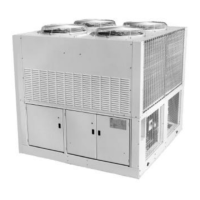14 IOMM ACZ/AGZ-1
d. If a vertical riser exists including the trap at the coil, determine the minimum tons for the
circuit.
Add b and c above to obtain the total equivalent feet. Use ASHRAE Table 3 (for R22) or Table 4 (for
R134a). Suction line selections are based upon the pressure equivalent of a 2ºF loss per 100
equivalent feet.
Select a line size that displays an equal or slightly larger tons then that determined in 1a) above.
To determine the actual line loss:
1. Modify the table tons by the value in Note 4 of Table 3 or 4 for the design condensing
temperature.
2. Use the formula in Note 3 to calculate the line loss in terms of the saturation temperature.
3. Convert the saturation temperature loss calculated to a pressure drop equivalent using the (Delta)
listed in the table for the comparable delta temperature.
Caution: Excessive pressure drop is undesirable because:
• It reduces available compressor capacity.
• It increases power consumed for the net tons realized.
• It may affect the performance of both the evaporator and the expansion valve previously selected
for the application.
The line loss calculated, expressed in temperature, or PSID pressure drop will be used to establish the
temperature required at the evaporator to produce the required cooling, as well as, the suction
pressure that the compressor must operate at to deliver the required capacity.
Having selected the suction line size, based upon total equivalent length and maximum tons, verify the
line size selected will maintain entrainment of the lubricating oil up any vertical risers at the minimum
tons for the circuit. See d above, and ASHRAE Table 2-13.
If the line size selected will not maintain satisfactory oil return in a suction riser, the following options
are available:
The vertical length can be sized smaller to accommodate the lower circuit tons at reduced load.
Minimum compressor capacity can be increased by eliminating the lowest step of compressor
capacity.
Hot gas bypass can be introduced at the distributor to the evaporator, increasing the volume of gas
available in the suction line to entrain the oil.
An oil separator may be installed in the discharge line.
With reciprocating compressor units only, and only as a last resort, double suction risers can be
utilized. Since a double suction riser works by providing an oil trap to assure the return of some oil,
with refrigerant, up the smaller diameter line, a) the trap must be as small as possible, b) there must not
be multiple traps, and c) whenever double risers are used in a suction line, a suction accumulator with
a controlled oil return must be installed in the line ahead of the compressor.
Note: In horizontal refrigerant gas lines, oil return to compressors is assured by sizing lines at a
velocity above the minimum recommended and pitching the lines in the direction of refrigerant flow.
Sizing A Double Riser
At maximum circuit tons, the line size should be selected from the table based upon the recommended
maximum line loss.
With the minimum tons known, a smaller line size should be selected from ASHRAE Chapter 2, Table
13 or 14 capable of entraining oil at the reduced tons. The smaller sized line should be the one
installed to be always active.

